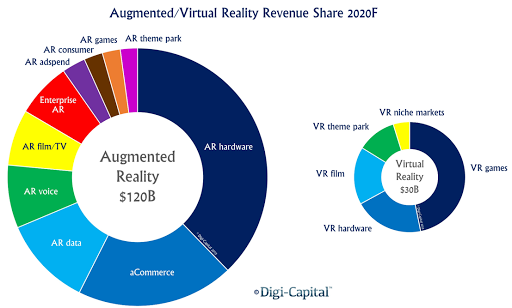Current & Future State of Mainstream Adoption of AR/VR Technology in Industry
- ATMECS – Content Team
Considering how crucial digital technology has become to daily life, technologies like Augmented and Virtual Reality have received mixed results in their adoption level and also evolved quite a bit since its first depiction in 1920. Augmented reality is an enhanced state of experience, where virtual elements are infused into the real world and are amplified by computer-generated information that can affect various senses.
With the introduction of smartphones and smart wearables, the demand and opportunities for mass customization of AR have risen. On the other hand, the applications of virtual reality function entirely online. This is where human elements are infused into the virtual world, and through the use of special gloves or goggles, a person can interact with it.

Though the idea was established earlier, the adoption of these technologies took a while due to many reasons like production costs, or poor user experience design. However, slowly but steadily, a comeback is being made as niche-level applications are gaining global attraction. At present, 71% of customers are willing to shop more if they can use AR.
Current challenges in the adoption of Adoption of AR/VR Technology in Industry
Though the adoption of AR/VR is making smooth progress, certain current challenges have created an issue in its adoption into various industries.

⦁ Managing the high production prices
Like any other technology, a certain amount is set aside to produce AR/VR devices. However, due to AR/VR still being a new concept, the technological world has to evolve more to create an easier production process, thus reducing cost factors, before becoming mainstream and requiring more capital. The first way a manufacturer makes their money back is through sales. However, due to its high prices, not many are inclined to buy it. Unlike a smartphone which has become a necessity to daily life, AR/VR devices are still considered a luxury.
⦁ Consumer electronics are not up to par
Even though many individuals may have the latest model in terms of smartphones and other devices, they still cannot enjoy the full AR/VR experience. This is mainly due to the poor visual quality and minimal focal view. While a person might taste the AR/VR world through their electronics, it will not provide the best immersive experience.
⦁ Internet connection
Having an internet connection is critical to make it through daily life. However, most have up to 4G connectivity. 5G connectivity is recommended to enjoy the AR/VR experience and provide the best form of stability. However, not much is known and accepted about it. Most individuals are likely to avoid 5G connections as there is more negative feedback to one’s health and smartphone.
The future in Adoption of AR/VR Technology in Industry
At present, there are a wide number of products and devices like optical projection displays and head-mounted display devices that function through the use of AR/VR software in the market. Though this brings a new level of experience to those who use it, certain limitations are also present like poor visual quality and poor field of view. On the VR platform, many of the VR devices rely on smartphones to function daily.
Though these devices are easy to use and portable, it does not allow for an immersive experience due to the small screen and lack of visual quality. Considering that a lot of people now watch movies and play games on their smartphones, the next stage is to see how an immersive experience can be reached to help maximize a user’s experience. Though the future of AR/VR has a lot of potentials, due to the current challenges that it faces, it is underperforming. With the continuous evolution and systematic changes that are being made to help improve these technologies, the future is starting to look more promising in its mainstream adoption.

Though in the early stages, manufacturers are already showing interest in producing a mixture of both units. 67% of advertising agencies have stated that they are using AR technology more.
At the moment, AR/VR devices lack a natural and personalized aspect that gives the users a completely immersive experience. However, with how fast the technology world evolves through the emergence of cloud tech, 5G tech, and data and content ubiquity, it will be just a matter of a few years before one can enjoy an unconstrained AR/VR experience.
Providing the latest technological services, ATMECS is a company that brings visible digital transformation for their clients to embrace AR/VR experiences and technologies. Though AR/VR is widely accepted, there are many ways to improve these technologies with the help of the latest technological advances in the market. Based on the Grand View Research 2020 report, VR will have a 21.6% compound annual growth rate from 2020 to 2027. That is why the future adoption of AR/VR technologies in various industries will become mainstream as it continues to improve and assist with daily life functions.
ATMECS can help you – Let’s Partner.
Sources:
https://insights.dice.com
https://techcrunch.com
https://www.jabil.com
https://www.oberlo.in



